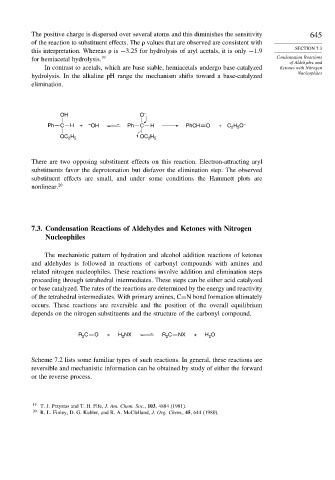Page 663 - Advanced Organic Chemistry Part A - Structure and Mechanisms, 5th ed (2007) - Carey _ Sundberg
P. 663
The positive charge is dispersed over several atoms and this diminishes the sensitivity 645
of the reaction to substituent effects. The values that are observed are consistent with
SECTION 7.3
this interpretation. Whereas is −3 25 for hydrolysis of aryl acetals, it is only −1 9
for hemiacetal hydrolysis. 19 Condensation Reactions
of Aldehydes and
In contrast to acetals, which are base stable, hemiacetals undergo base-catalyzed Ketones with Nitrogen
Nucleophiles
hydrolysis. In the alkaline pH range the mechanism shifts toward a base-catalyzed
elimination.
OH O –
Ph C H + – OH Ph C H PhCH O + C H O –
2 5
H OC H
OC 2 5 2 5
There are two opposing substituent effects on this reaction. Electron-attracting aryl
substituents favor the deprotonation but disfavor the elimination step. The observed
substituent effects are small, and under some conditions the Hammett plots are
nonlinear. 20
7.3. Condensation Reactions of Aldehydes and Ketones with Nitrogen
Nucleophiles
The mechanistic pattern of hydration and alcohol addition reactions of ketones
and aldehydes is followed in reactions of carbonyl compounds with amines and
related nitrogen nucleophiles. These reactions involve addition and elimination steps
proceeding through tetrahedral intermediates. These steps can be either acid catalyzed
or base catalyzed. The rates of the reactions are determined by the energy and reactivity
of the tetrahedral intermediates. With primary amines, C=N bond formation ultimately
occurs. These reactions are reversible and the position of the overall equilibrium
depends on the nitrogen substituents and the structure of the carbonyl compound.
R C O + H NX R C NX + H O
2
2
2
2
Scheme 7.2 lists some familiar types of such reactions. In general, these reactions are
reversible and mechanistic information can be obtained by study of either the forward
or the reverse process.
19 T. J. Przystas and T. H. Fife, J. Am. Chem. Soc., 103, 4884 (1981).
20
R. L. Finley, D. G. Kubler, and R. A. McClelland, J. Org. Chem., 45, 644 (1980).

